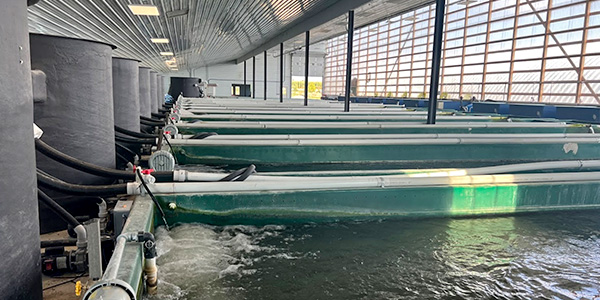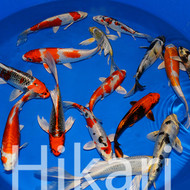The Hikari Classes - vol. 1
Posted by Ellen Kloubec on 1st Nov 2022
There are 3 classes of Hikari Koi; Hikari Muji, Hikari Utsuri and Hikari Moyo. There are many varieties that fall into each class. Some are easy to recognize and some may take a little more time and effort to distinguish. Often the lines become blurred between one type and another but with practice you will become adept at identifying each type. In this blog article I will explain the similarities and differences between the koi in these three popular classes and how to identify each.
Luster & Shine
The most common feature of all koi in the Hikari groups is their skin. The skin is metallic; shimmery metallic skin with luster. The term ‘luster’ refers to the light reflecting quality of the skin. It can be compared to a piece of satin material; bright, iridescent, and thick, with heavy sheen. A koi’s metallic skin should shine like polished gun metal. Luster should cover the entire koi, from tip of the nose to tip of the tail, even the fins. A strong luster is highly desired. The quality and consistency of luster is severely judged. After all, metallic skin is the most distinguishing characteristic of the Hikari varieties and the reason for grouping them together in these three classes.
Another similarity of the koi in the Hikari classes is the base color. Many varieties have a Platinum base color, plus the addition of at least one other color.
Hikari Muji (Hikari Mono)
The first class to review is the Hikari Muji, or Hikari Mono group. The koi in this class are single colored metallic fish. In the Japanese language the word Hikari means shining, so it makes sense that this class would contain koi that have bright and shiny metallic skin. Likewise, Muji (Mono) meaning one, refers to the fact that they are single colored koi, devoid of pattern or markings. There are many koi of one color in this class, most are Ogon. Every fish in the Hikari Muji class is a single colored metallic koi.
Varieties of Koi in the Hikari Muji class
- Yamabuki Ogon – A yellow colored metallic koi
- Platinum Ogon – A white colored metallic koi
- Orengi Ogon – An orange colored metallic koi
- Hi Ogon – A red colored metallic koi
- Nezu Ogon – A gray-brown colored metallic koi
Luster on the Ogon’s skin is of utmost importance. The luster should extend completely over the body and fins. This shimmery sheen will make your Ogon visible even in water of less than desirable clarity. A strong luster or sheen is highly regarded.
Color is also a major characteristic to consider on Hikari Muji varieties. It should be one solid and consistent color, from the nose to the tail with no variance. When color is rich and constant it is referred to as deep or thick. The head and body should be clear of random pigments or blemishes on Hikari Muji varieties. The pectoral fins should also be the same color as the body. However, some Ogons have white tipped fins, which is acceptable.
More varieties of Koi in the Hikari Muji class
- Kin Matsuba – Gold colored metallic koi with reticulation on scales
- Gin Matsuba – Silver colored metallic koi with reticulation on scales
These Matsuba varieties are single colored metallic koi just like the Ogons. However, they have isolated sumi (black) on the center of each scale. This feature is called reticulation and is generally referred to as ‘pinecone scales’ and is translated as such. The addition of sumi on the scales does not eliminate them from the Hikari Muji class because the dark centers are not considered pattern, so in this class they stay.
The same recommendations for depth and clarity of color apply to Matsuba that apply to the Ogon. Sheen or luster is also expected on the metallic Matsuba. It should cover the entire fish including the fins, producing a smooth polished appearance.
Hikari Utsuri
In this class, we find multi-colored koi with metallic skin. One color is always black, (sumi) because of their Utsuri lineage. If the koi has two colors we see black and red, black and white, or black and yellow. If it is a three colored fish then we see black, red, and white. However, the colors are generally distorted by the metallic quality of the skin. Black is often diffused and appears a smoky gray rather than the inky black we are accustomed to seeing. Likewise, the red can become a brown-ish orange when altered by the heavy luster. It is rare that any of the pigments are their typical hue when appearing over strong luster.
The patterns of Hikari Utsuri koi parallel those of traditional Showa and Utsuri; large patches of color, beginning at the nose and extending over the entire body. In the Japanese language Utsuri means reflection. Reflection refers to the formation of the pattern, or the way the two colors alternate to mimic a checkerboard; each color opposite of the other. The big patches of color wrap around the fish often down to the belly. These patterns are very impressive on glistening metallic skin. The Hikari Utsuri pattern is graded with the same principles as their non-metallic counterparts, Showa and Utsuri.
Just like the Hikari Muji class, a high luster on the skin is vitally important. The luster should cover the body completely and extend over the fins as well.
Varieties of Koi in the Hikari Utsuri class
- Kin Showa-metallic Showa, three colors: black red and white
- Gin Shiro Utsuri-metallic Shiro Utsuri, two colors: black and white
- Kin Ki Utsuri-metallic Ki Utsuri, two colors: black and yellow
- Kin Hi Utsuri-metallic Hi Utsuri, two colors: black and red
Hikari Moyo
Finally, we come to the Hikari Moyo class. Just like the previous two groups, the class name begins with the word Hikari. (Remember, that Hikari means ‘shining’). So, the koi in this class have iridescent metallic skin, too, but each will have two or more colors. They all have metallic skin, more than one color, plus a pattern. Although, there are no checkerboard patterns in this class because these koi are not of Utsuri lineage.
Each koi in the Hikari Moyo class has a bright Platinum (white) base color. All have at least one additional color. The word Moyo means ‘many’ which refers to their multiple colors. Some varieties will have two colors, some three and even four colors. These additional pigments form interesting patterns, though pattern is not the hallmark of this group.
Being a Hikari variety means that the luster is harshly judged in this group, too. Again, a glistening sheen should cover the entire body and spread to the tips of the fins. All varieties in Hikari Moyo class will have flashy white pectoral fins.
Varieties of Koi in the Hikari Moyo class
- Hariwake-Platinum koi with orange or yellow pattern
- Yamatonishiki-metallic Sanke
- Kujaku-Platinum base with reticulation on scales and orange pattern
- Kikusui-Platinum koi with red pattern, always Doitsu (scale-less)
- Gin Bekko-metallic Bekko
By using the information in this article you can easily identify your favorite metallic koi variety and determine in which Hikari class it belongs.
To help with koi identification, and see illustrations of koi varieties, visit our website and the Ellen’s Koi Education tab.


